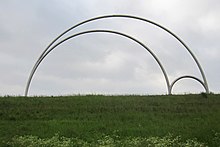Arbelos
The Arbelos ( Greek Άρβυλος Arbylos for "shoemaker's knife") or Archimedes' sickle is a special geometric figure delimited by three semicircles. The famous Greek mathematician Archimedes is said to have studied the properties of Arbelos and described them in his Book of Lemmas .
Description and characteristics
On the diameter of a semicircle you choose a point and then erect semicircles above and . The crescent-shaped residual figure that arises when you remove the semicircles above and from the semicircle above is called Arbelos .
If you establish a perpendicular to the diameter at the point , this cuts the associated semicircle . One of the most famous statements about the Arbelos is that the area of the circle with the diameter corresponds to the area of the Arbelos. The following applies:
proofs
Using explicit area calculations
Draw the auxiliary triangle . According to Thales's theorem , the triangle is right-angled and the side is its hypotenuse, consisting of the sections and . According to Euclid's theorem of heights , the square above the height of the triangle is equal to the product of the two hypotenuse sections:
The circle whose diameter goes through and has the radius . So the height of the triangle is . The distance is the diameter of the large semicircle. If one names the radius of the smaller semicircle and that of the smallest semicircle , then is . The radius of the large semicircle is therefore half of , so .
After high rate of Euclid applies: so .
With algebraic methods (i.e. abstract calculation - these were not yet available to the Greeks) you can quickly see that the claim is correct (but you do not gain any insight into why this is so). The area of the arbelos is equal to the area of the large semicircle minus the area of the two small semicircles:
The area of the circle that goes through and is . As shown above, after the second sentence of Euclid applies . It can therefore be used in the formula for the area of the Arbelos instead of now , thus resulting in:
- .
This proves that the area of the Arbelos is equal to that of the circle that goes through and through .
Visual proof of equality of area
The following particularly simple proof of area equality uses a generalization of the Pythagorean theorem to similar figures and does not require any area formulas or explicit area calculations.
Other properties
The length of the large arch corresponds to the sum of the lengths of the two smaller arches, so:
Accordingly, it also applies that the circumference of the large semicircle corresponds to the sum of the circumference of the two smaller semicircles.
The circle with the same area as the Arbelos intersects the semicircle over in and the semicircle over in . These two intersection points have a number of special properties, for example their connecting line is another diameter of the circle and the chordal quadrangle is a rectangle whose diagonals are the lines and . In addition, the connecting line lies on the common (outer) tangent of the semicircles above and and the point lies on the line and the point on the line .
If one divides the Arbelos along the vertical , an inscribed circle can be constructed for each half, which touches the vertical, the outer semicircle and one of the inner semicircles (special case of the Apollonian problem ). These two circles have the same radius with
and are referred to as the twin circles of Archimedes .
The from the contact point of the two inner half-circles and the centers of , , of the quadrilateral three half-circular arcs formed is a rectangle and its surface is:
If you carry out a new Arbelos construction with the two inner semicircles of an arbelos, which is similar to the starting arbelos, then the two new inner semicircles with the common point are equal in area.
Variants and generalizations
- The construction principle of the Arbelos can also be implemented with other curves instead of semicircles. If the semicircles are replaced by parabolic segments , the resulting figure is called Parbelos .
- A generalization that encompasses both the Arbelos and the Parbelos is the f -belos, which uses (similar) segments of differentiable functions to construct.
See also
literature
- Günter Aumann : Circular Geometry: An Elementary Introduction . Springer, 2015, ISBN 9783662453063 , pp. 193-200
- RA Johnson : Modern Geometry: An Elementary Treatise on the Geometry of the Triangle and the Circle . Houghton Mifflin, Boston 1929, pp. 116-117.
- L. Raphael: The Shoemaker's Knife . In: The Mathematics Teacher , Volume 66, No. 4 (APRIL 1973), pp. 319–323 ( JSTOR )
- Harold P. Boas : Reflections on the Arbelos . In: The American Mathematical Monthly , Volume 113, No. 3 (March, 2006), pp. 236–249 ( JSTOR )
Web links
- Eric W. Weisstein : Arbelos . In: MathWorld (English).
- Interactive diagram that visualizes numerous properties
- Arbelos on mathematische-basteleien.de
Individual evidence
- ^ A b c RA Johnson: Modern Geometry: An Elementary Treatise on the Geometry of the Triangle and the Circle . Houghton Mifflin, Boston 1929, pp. 116-117.
- ^ Roger B. Nelsen: Proof without Words: The Area of an Arbelos . In: Mathematics Magazine , Volume 75, No. 2 (Apr., 2002), p. 144
- ^ A b Günter Aumann: Circular Geometry: An Elementary Introduction . Springer, 2015, ISBN 9783662453063 , pp. 193-200
- ↑ a b c Jonathan Sondow: The Parbelos, a Parabolic Analog of the Arbelos . In: The American Mathematical Monthly , Volume 120, No. 10 (December 2013), pp. 929-935 ( JSTOR )
- ↑ Antonio M. Oller-Marcen: The f-belos . In: Forum Geometricorum , Volume 13 (2013), pp. 103–111.








































